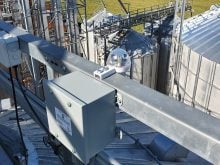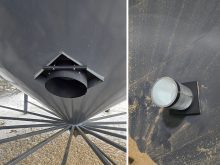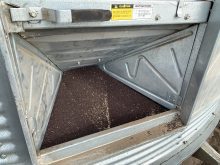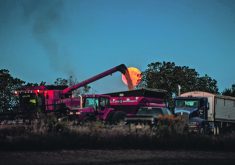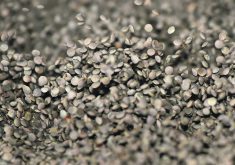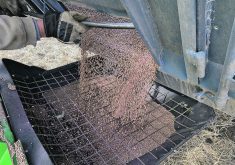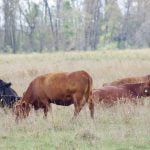As expanding farmers buy or rent more land, their first priority is securing the necessary seeding rigs, sprayers and then harvest equipment. There’s no denying the logic of this chronology. Without field equipment, there is no crop.
However, the rush to address cropping requirements of those new acres means the grain-handling assets required to service them is often overlooked until the day that crop is staring you in the eye, says GSI grain-handling specialist Gary Woodruff.
He says it’s wrong to assume that the new operator will be able to just pick up and handle all the crop managed by the land’s previous owner. He says the previous owner may have had storage, handling and marketing options not available to the new owner.
Read Also

Regulatory model “broken” in Canada – says BASF
Taking a decade to assess the safety of glufosinate-ammonium, a herbicide branded as Liberty that has been used by farmers for years, embodies what’s wrong with Canada’s regulatory system, BASF said.
“Whether you’re just adding a quarter or you’re talking major expansion, you may be approaching that point where simple augers and bins scattered around the countryside no longer serve your purpose,” says Woodruff.
“If you’re contemplating more acres, but the situation is that you’re just barely getting by at your current bin yard, then you should maybe start considering a leg system with a dump pit or at least VersaLoops.”
He says VersaLoop looks like an auger on the outside, but inside it’s a chain loop with a delivery pipe and a return pipe just above. It uses UHMW paddles to gently pull the grain. There’s less grain damage than with a conventional auger. It moves grain up an incline of 60 degrees to load taller bins. The drive and all serviceable parts are located at the bottom, allowing easy access.
Woodruff says he normally doesn’t see the need to move to a leg or VersaLoop or other engineered high-volume system until there’s more than 100,000 bushels of crop to handle. He says the volume threshold can be as high as 200,000 bushels on some prairie farms.
The real crunch, he says, comes at the first big harvest when there is no more space for rent at the elevator and the semis are wasting time hauling anywhere they can find room.
Then it turns to desperation time, when you start piling grain on the ground. And, to top off the worst-case scenario, that’s is inevitably when the rain comes. Farmers reach the decision point when they see how much money they’re losing in efficiency and in quality downgrades.
“The typical situation we see is where a guy has a couple 20,000-bushel bins, he’s added a 40,000-bu. bin a few years ago, and now he needs to add 60,000 bu. And the size and layout is beyond what he can handle with a conventional big auger and swing-away auger. Now he has to do something.
“Once you get to eight or nine rings on your tank or a 40-foot eave, that’s beyond the height you can easily handle with an auger. And if you try, it’ll eat up a tremendous amount of power. You’ve gotten to the point where you’re so big and you’re handling such a huge volume that you simply cannot do it the old way anymore.
“Your trucks are standing in line. You’ve had to reduce your harvest speed, and that’s a killer. At that point, it pretty well forces you to do something different.”
Experts say wet grain should not sit in the hopper tank longer than one day. However, that’s exactly what happens if the hopper feeding your dryer is too large. Woodruff says farmers have a natural tendency in all equipment purchases to assume that a size too big is better than a size too small. While it may be true in other purchases, it’s not true when buying a wet hopper.
“The key thing to remember about sizing your dryer and wet tank is we’re just talking about grain in front of the dryer. A lot of guys will put in a big hopper tank, but that’s backwards. That hopper tank in front of the dryer needs to be small enough that it totally empties once every day.
“If you’ve got a dryer that does 10,000 bu. a day and you install a 30,000-bu. wet tank because you think that’ll give you some surge capacity, it’s not going to work. Remember that on a hopper tank, the first grain in is the last grain out.
“If you’ve got a hopper tank that doesn’t drain empty every day, that first grain you put in never leaves that tank until everything is run through. Within a week, you’ll be going into that hopper on a rope with your pickaxe to chop grain out of there. That’s not something you want to do ever.”
As obvious as that scenario might seem when it’s explained, Woodruff says it’s one of the most common mistakes he sees when systems have not been designed by specialized grain-handling engineers.
He says a rule of thumb when determining size is the wet tank should hold enough grain for eight to 12 hours of the dryer capacity. If your dryer handles 10,000 bu. a day, then you shouldn’t have more than a 5,000 bu. wet tank. That ratio will ensure that the dryer runs all night so you get good efficiency out of the unit, but also ensures that the wet tank is empty first thing in the morning.
If the wet tank isn’t empty first thing in the morning, Woodruff says the smartest thing farmers can do is go do something else. They shouldn’t add more grain until the wet tank is cleaned out.
He says he recommends a maximum ratio of 12 hours wet tank capacity. Average farm size is expanding so rapidly, as is dryer size. A hopper tank that holds 12 hours of wet grain today may hold only eight hours of grain a few years from now.
Woodruff says expanding farmers in the corn belt, where he does most of his work, have gone through the same dilemma as Canadian prairie farmers when it comes to dealing with their wide array of bins scattered further than the eye can see.
On the Prairies, those remote sites often don’t have three-phase. The bins may be small but there’s lots of them, and they do hold grain, so they do have value.
“This can be a serious problem if you don’t handle it well, because each one of those small bin locations has value. We went through that scenario about 20 years ago down here, and it actually worked out pretty well.
“Guys have taken those four or five smaller systems and specialized them. One site might be just for soybeans, so it’s equipped for soybeans. Another one or two might be for cereals.”
On the Canadian Prairies, where farmers typically have longer rotations, it might be possible to set up one bin site for canola, one for beans, one for pulse crops, one for corn and another for cereals. The remote bin yards will be set aside for crops that require less attention, and which may not need three-phase power, says Woodruff. The remote bins might also be used for dried grain.
Although moving bins is also an option, Woodruff points out that it may be better to maintain all the remote bin sites in their original location if the farm is spread out. When harvest is tight, this can cut down on the length of truck trips, or it can allow the semis haul to the main site, while grain carts haul to the nearby bins.
Another option is to use remote sites to store grain that has already gone through the dryer. The semis haul tough grain to the main yard. Instead of dead heading on the backhaul to the field, the semi brings dry grain to the remote sites, and it’s shipped to market from there. This plan is especially appealing if those remote bins lack power.
“All these various plans for multiple bin sites can be a nuisance. There’s no doubt they require a higher level of management. But let’s face it, you can’t just always throw dollars at things. It would be nice to design and build a complete new storage and handling facility from scratch, on a fresh piece of ground. But very few people can afford to do it all at once.




